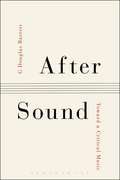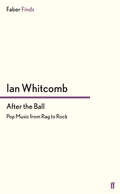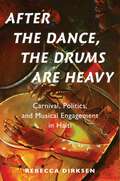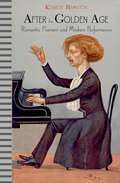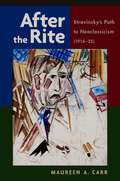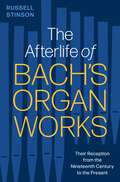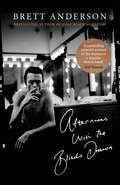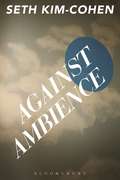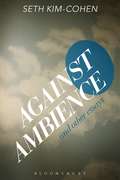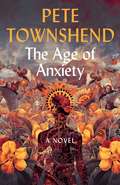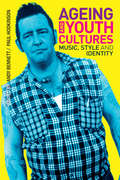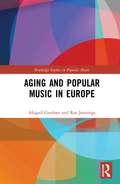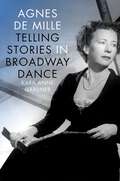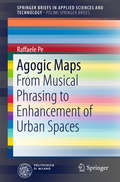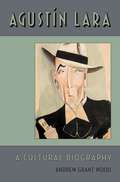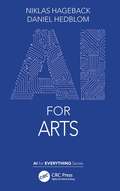- Table View
- List View
After Sound: Toward a Critical Music
by G Douglas BarrettAfter Sound considers contemporary art practices that reconceive music beyond the limitation of sound. This book is called After Sound because music and sound are, in Barrett's account, different entities. While musicology and sound art theory alike typically equate music with pure instrumental sound, or absolute music, Barrett posits music as an expanded field of artistic practice encompassing a range of different media and symbolic relationships. The works discussed in After Sound thus use performance, text scores, musical automata, video, social practice, and installation while they articulate a novel aesthetic space for a radically engaged musical practice. Coining the term "critical music," this book examines a diverse collection of art projects which intervene into specific political and philosophical conflicts by exploring music's unique historical forms. Through a series of intimate studies of artworks surveyed from the visual and performing arts of the past ten years-Pussy Riot, Ultra-red, Hong-Kai Wang, Peter Ablinger, Pauline Boudry and Renate Lorenz, and others-After Sound offers a significant revision to the way we think about music. The book as a whole offers a way out of one of the most vexing deadlocks of contemporary cultural criticism: the choice between a sound art effectively divorced from the formal-historical coordinates of musical practice and the hermetic music that dominates new music circles today.
After the Ball: Pop Music from Rag to Rock (Limelight Ser.)
by Ian WhitcombFirst published in 1972, Ian Whitcomb's After the Ball is an exuberant account of the origins and explosion of popular music, informed by the author's store of experience in the field as a pop sensation of The Sixties.'Brash, learned, funny and perspicacious.... The author of this free-wheeling, diverting history was a student at Trinity College, Dublin, when he created a rock hit 'You Turn Me On,' and experienced a brief, bewildering season as a touring rock celebrity. This book... is his effort to explain that experience to himself, and, well-educated man that he is, he goes all the way back to the first pop bestseller (in sheet music, of course), 'After The Ball,' and all the way forward to the 1960s.' New Yorker 'One of the best books on popular music to come along in the last few years.... Whitcomb's own involvement with music constantly surfaces to make the book both revealing and highly enjoyable.' Seattle Times
AFTER THE DANCE,DRUM IS HEAVY CILAM C: Carnival, Politics, and Musical Engagement in Haiti (Currents in Latin American and Iberian Music)
by Rebecca DirksenRichly ethnographic and a compelling read, After the Dance, the Drums Are Heavy is a study of carnival, politics, and the musical engagement of ordinary citizens and celebrity musicians in contemporary Haiti. The book explores how the self-declared president of konpa Sweet Micky (Michel Martelly) rose to the nation's highest office while methodically crafting a political product inherently entangled with his musical product. It offers deep historical perspective on the characteristics of carnivalesque verbal play-and the performative skillset of the artist (Sweet Micky) who dominated carnival for more than a decade-including vulgarities and polemics. Yet there has been profound resistance to this brand of politics led by many other high-profile artists, including Matyas and Jòj, Brothers Posse, Boukman Eksperyans, and RAM. These groups have each released popular carnival songs that have contributed to the public's discussions on what civic participation and citizenship in Haiti can and should be. Drawing on more than a decade and a half of ethnographic research, Rebecca Dirksen presents an in-depth consideration of politically and socially engaged music and what these expressions mean for the Haitian population in the face of challenging political and economic circumstances. After the Dance, the Drums Are Heavy centers the voices of Haitian musicians and regular citizens by extensively sharing interviews and detailed analyses of musical performance in the context of contemporary events well beyond the musical realm.
After the Dance, the Drums Are Heavy: Carnival, Politics, and Musical Engagement in Haiti (Currents in Latin American and Iberian Music)
by Rebecca DirksenRichly ethnographic and a compelling read, After the Dance, the Drums Are Heavy is a study of carnival, politics, and the musical engagement of ordinary citizens and celebrity musicians in contemporary Haiti. The book explores how the self-declared president of konpa Sweet Micky (Michel Martelly) rose to the nation's highest office while methodically crafting a political product inherently entangled with his musical product. It offers deep historical perspective on the characteristics of carnivalesque verbal play-and the performative skillset of the artist (Sweet Micky) who dominated carnival for more than a decade-including vulgarities and polemics. Yet there has been profound resistance to this brand of politics led by many other high-profile artists, including Matyas and Jòj, Brothers Posse, Boukman Eksperyans, and RAM. These groups have each released popular carnival songs that have contributed to the public's discussions on what civic participation and citizenship in Haiti can and should be. Drawing on more than a decade and a half of ethnographic research, Rebecca Dirksen presents an in-depth consideration of politically and socially engaged music and what these expressions mean for the Haitian population in the face of challenging political and economic circumstances. After the Dance, the Drums Are Heavy centers the voices of Haitian musicians and regular citizens by extensively sharing interviews and detailed analyses of musical performance in the context of contemporary events well beyond the musical realm.
After the Golden Age: Romantic Pianism and Modern Performance
by Kenneth HamiltonKenneth Hamilton's book engagingly and lucidly dissects the oft-invoked myth of a Great Tradition, or Golden Age of Pianism. It is written both for players and for members of their audiences by a pianist who believes that scholarship and readability can go hand-in-hand. Hamilton discusses in meticulous yet lively detail the performance-style of great pianists from Liszt to Paderewski, and delves into the far-from-inevitable development of the piano recital. He entertainingly recounts how classical concerts evolved from exuberant, sometimes riotous events into the formal, funereal trotting out of predictable pieces they can be today, how an often unhistorical "respect for the score" began to replace pianists' improvisations and adaptations, and how the clinical custom arose that an audience should be seen and not heard. Pianists will find food for thought here on their repertoire and the traditions of its performance. Hamilton chronicles why pianists of the past did not always begin a piece with the first note of the score, nor end with the last. He emphasizes that anxiety over wrong notes is a relatively recent psychosis, and playing entirely from memory a relatively recent requirement. Audiences will encounter a vivid account of how drastically different are the recitals they attend compared to concerts of the past, and how their own role has diminished from noisily active participants in the concert experience to passive recipients of artistic benediction from the stage. They will discover when cowed listeners eventually stopped applauding between movements, and why they stopped talking loudly during them. The book's broad message proclaims that there is nothing divinely ordained about our own concert-practices, programming and piano-performance styles. Many aspects of the modern approach are unhistorical-some laudable, some merely ludicrous. They are also far removed from those fondly, if deceptively, remembered as constituting a Golden Age.
After the Golden Age: Romantic Pianism and Modern Performance
by Kenneth HamiltonKenneth Hamilton's book engagingly and lucidly dissects the oft-invoked myth of a Great Tradition, or Golden Age of Pianism. It is written both for players and for members of their audiences by a pianist who believes that scholarship and readability can go hand-in-hand. Hamilton discusses in meticulous yet lively detail the performance-style of great pianists from Liszt to Paderewski, and delves into the far-from-inevitable development of the piano recital. He entertainingly recounts how classical concerts evolved from exuberant, sometimes riotous events into the formal, funereal trotting out of predictable pieces they can be today, how an often unhistorical "respect for the score" began to replace pianists' improvisations and adaptations, and how the clinical custom arose that an audience should be seen and not heard. Pianists will find food for thought here on their repertoire and the traditions of its performance. Hamilton chronicles why pianists of the past did not always begin a piece with the first note of the score, nor end with the last. He emphasizes that anxiety over wrong notes is a relatively recent psychosis, and playing entirely from memory a relatively recent requirement. Audiences will encounter a vivid account of how drastically different are the recitals they attend compared to concerts of the past, and how their own role has diminished from noisily active participants in the concert experience to passive recipients of artistic benediction from the stage. They will discover when cowed listeners eventually stopped applauding between movements, and why they stopped talking loudly during them. The book's broad message proclaims that there is nothing divinely ordained about our own concert-practices, programming and piano-performance styles. Many aspects of the modern approach are unhistorical-some laudable, some merely ludicrous. They are also far removed from those fondly, if deceptively, remembered as constituting a Golden Age.
After the Rite: Stravinsky's Path to Neoclassicism (1914-1925)
by Maureen A. CarrThe riot that erupted during the 1913 debut of Igor Stravinsky's The Rite of Spring at the Théâtre des Champs-Élysées in Paris has long been one of the most infamous and intriguing events of modern musical history. The third in a series of works commissioned for Sergei Diaghalev's famed Ballets Russes, the piece combined disjunct tonalities, provocative rhythms, and radical choreography that threw spectators and critics into a literal fury. In the century following its premiere, The Rite of Spring has demonstrated its earth-shattering impact on music and dance as well as its immortalizing effect on Stravinsky and his career. Having gained international attention by the age of 30, what direction could Stravinsky's path forward take after the momentus events of 1913? After the Rite: Stravinsky's Path to Neoclassicism (1914-1925) traces the evolution of Stravinsky's compositional style as he searched for his own voice in the explosive musical world of the early 20th century as he responded to harsh criticisms of his work. Throughout the book, author Maureen Carr presents new transcriptions and sophisticated analyses of selected musical sketches to show the genesis of Stravinsky's musical ideas as he forayed into surrealism, classicism, and abstraction to develop his signature Neoclassical style. Exploring these annotated compositional experiments--such as the earliest evidence of Stravinsky's appropriation of the "rag idiom" and the development of his so-called "sound blocks"--After the Rite provides new insight into how Stravinsky challenged and guided the musical developments of the decade after that legendary Paris premiere. Enlightening visual metaphors, such as the contemporary paintings of Paul Klee and those of the Russian futurists, supplement discussion of the musical sketches throughout, offering a comprehensive artistic context for Carr's unprecedented and rigorous examination. A treasure trove of outstanding material for scholars, musicians, students, and general readers alike, After the Rite offers a much-needed delineation of the concept of musical neoclassicism. Maureen Carr's innovative and detailed examination of the metamorphosis of Igor Stravinsky's compositional style after The Rite of Spring is an invaluable contribution to the literature concerning this iconic 20th century composer.
The Afterlife of Bach's Organ Works: Their Reception from the Nineteenth Century to the Present
by Russell StinsonThe music of J. S. Bach continues to be revered and celebrated centuries after his death. Its timelessness can be attributed to masterful musical engineering combined with profound expressivity. In other words, Bach's unique art may represent the pinnacle of contrapuntal technique, but it is just as amazing for its depth of emotion. Bach's compositions remain an indispensable part of the classical-music canon today. The Afterlife of Bach's Organ Works explores the critical impact made on posterity by Bach's organ music. It concerns a diverse group of musicians and non-musicians alike--some famous, some forgotten--who in one way or another became champions of these compositions. These individuals performed the music; edited it for publication; promoted it by means of books, articles, and reviews; transcribed it for other media; taught it to their pupils; shared it with their family and friends; and incorporated it into the soundtracks of their motion pictures. They ensured its "afterlife." In five chapters, organist and Bach expert Russell Stinson traces the historical afterlife of Bach's organ music from the early nineteenth century--the era of the so-called Bach revival--to the present day. Engagingly written and containing a wealth of information previously unavailable in English, the book is a history of performance practice, an aesthetic history of musical taste, and a social history. Each chapter tells the story of how and why Bach's organ works have stood the test of time.
The Afterlife of Bach's Organ Works: Their Reception from the Nineteenth Century to the Present
by Russell StinsonThe music of J. S. Bach continues to be revered and celebrated centuries after his death. Its timelessness can be attributed to masterful musical engineering combined with profound expressivity. In other words, Bach's unique art may represent the pinnacle of contrapuntal technique, but it is just as amazing for its depth of emotion. Bach's compositions remain an indispensable part of the classical-music canon today. The Afterlife of Bach's Organ Works explores the critical impact made on posterity by Bach's organ music. It concerns a diverse group of musicians and non-musicians alike--some famous, some forgotten--who in one way or another became champions of these compositions. These individuals performed the music; edited it for publication; promoted it by means of books, articles, and reviews; transcribed it for other media; taught it to their pupils; shared it with their family and friends; and incorporated it into the soundtracks of their motion pictures. They ensured its "afterlife." In five chapters, organist and Bach expert Russell Stinson traces the historical afterlife of Bach's organ music from the early nineteenth century--the era of the so-called Bach revival--to the present day. Engagingly written and containing a wealth of information previously unavailable in English, the book is a history of performance practice, an aesthetic history of musical taste, and a social history. Each chapter tells the story of how and why Bach's organ works have stood the test of time.
Afternoons with the Blinds Drawn
by Brett Anderson'A compelling personal account of the dramas of a singular British band' Neil TennantThe trajectory of Suede - hailed in infancy as both 'The Best New Band in Britain' and 'effete southern wankers' - is recalled with moving candour by its frontman Brett Anderson, whose vivid memoir swings seamlessly between the tender, witty, turbulent, euphoric and bittersweet. Suede began by treading the familiar jobbing route of London's emerging new 1990s indie bands - gigs at ULU, the Camden Powerhaus and the Old Trout in Windsor - and the dispiriting experience of playing a set to an audience of one. But in these halcyon days, their potential was undeniable. Anderson's creative partnership with guitarist Bernard Butler exposed a unique and brilliant hybrid of lyric and sound; together they were a luminescent team - burning brightly and creating some of the era's most revered songs and albums.In Afternoons with the Blinds drawn, Anderson unflinchingly explores his relationship with addiction, heartfelt in the regret that early musical bonds were severed, and clear-eyed on his youthful persona. 'As a young man . . . I oscillated between morbid self-reflection and vainglorious narcissism' he writes. His honesty, sharply self-aware and articulate, makes this a compelling autobiography, and a brilliant insight into one of the most significant bands of the last quarter century.
Against Ambience
by Seth Kim-CohenAgainst Ambience diagnoses - in order to cure - the art world's recent turn toward ambience. Over the course of three short months - June to September, 2013 - the four most prestigious museums in New York indulged the ambience of sound and light: James Turrell at the Guggenheim, Soundings at MoMA, Robert Irwin at the Whitney, and Janet Cardiff at the Met. In addition, two notable shows at smaller galleries indicate that this is not simply a major-donor movement. Collectively, these shows constitute a proposal about what we want from art in 2013. It's impossible to play possum. While we're in the soft embrace of light, the NSA and Facebook are still collecting our data, the money in our bank accounts is still being used to fund who-knows-what without our knowledge or consent, the government we elected is still imprisoning and targeting people with whom we have no beef. We deserve an art that is the equal of our information age. Not one that parrots the age's self-assertions or modes of dissemination, but an art that is hyper-aware, vigilant, active, engaged, and informed. We are now one hundred years clear of Duchamp's first readymades. So why should we find ourselves so thoroughly in thrall to ambience? Against Ambience argues for an art that acknowledges its own methods and intentions; its own position in the structures of cultural power and persuasion. Rather than the warm glow of light or the soothing wash of sound, Against Ambience proposes an art that cracks the surface of our prevailing patterns of encounter, initiating productive disruptions and deconstructions.
Against Ambience and Other Essays
by Seth Kim-CohenAgainst Ambience diagnoses - in order to cure - the art world's recent turn toward ambience. Over the course of three short months - June to September, 2013 - the four most prestigious museums in New York indulged the ambience of sound and light: James Turrell at the Guggenheim, Soundings at MoMA, Robert Irwin at the Whitney, and Janet Cardiff at the Met. In addition, two notable shows at smaller galleries indicate that this is not simply a major-donor movement. Collectively, these shows constitute a proposal about what we wanted from art in 2013. While we're in the soft embrace of light, the NSA and Facebook are still collecting our data, the money in our bank accounts is still being used to fund who-knows-what without our knowledge or consent, the government we elected is still imprisoning and targeting people with whom we have no beef. We deserve an art that is the equal of our information age. Not one that parrots the age's self-assertions or modes of dissemination, but an art that is hyper-aware, vigilant, active, engaged, and informed. We are now one hundred years clear of Duchamp's first readymades. So why should we find ourselves so thoroughly in thrall to ambience? Against Ambience argues for an art that acknowledges its own methods and intentions; its own position in the structures of cultural power and persuasion. Rather than the warm glow of light or the soothing wash of sound, Against Ambience proposes an art that cracks the surface of our prevailing patterns of encounter, initiating productive disruptions and deconstructions.
Against Ambience and Other Essays
by Seth Kim-CohenAgainst Ambience diagnoses - in order to cure - the art world's recent turn toward ambience. Over the course of three short months - June to September, 2013 - the four most prestigious museums in New York indulged the ambience of sound and light: James Turrell at the Guggenheim, Soundings at MoMA, Robert Irwin at the Whitney, and Janet Cardiff at the Met. In addition, two notable shows at smaller galleries indicate that this is not simply a major-donor movement. Collectively, these shows constitute a proposal about what we wanted from art in 2013. While we're in the soft embrace of light, the NSA and Facebook are still collecting our data, the money in our bank accounts is still being used to fund who-knows-what without our knowledge or consent, the government we elected is still imprisoning and targeting people with whom we have no beef. We deserve an art that is the equal of our information age. Not one that parrots the age's self-assertions or modes of dissemination, but an art that is hyper-aware, vigilant, active, engaged, and informed. We are now one hundred years clear of Duchamp's first readymades. So why should we find ourselves so thoroughly in thrall to ambience? Against Ambience argues for an art that acknowledges its own methods and intentions; its own position in the structures of cultural power and persuasion. Rather than the warm glow of light or the soothing wash of sound, Against Ambience proposes an art that cracks the surface of our prevailing patterns of encounter, initiating productive disruptions and deconstructions.
The Age of Anxiety: A Novel
by Pete TownshendThe debut novel by Pete Townshend, one of the world's greatest rock starsA former rock star disappears on the Cumberland moors. When his wife finds him, she discovers he has become a hermit and a painter of apocalyptic visions.An art dealer has drug-induced visions of demonic faces swirling in a bedstead and soon his wife disappears, nowhere to be found.A beautiful Irish girl who has stabbed her father to death is determined to seduce her best friend's husband.A young composer begins to experience aural hallucinations, expressions of the fear and anxiety of the people of London. He constructs a maze in his back garden.Driven by passion and musical ambition, events spiral out of control - good drugs and bad drugs, loves lost and found, families broken apart and reunited. Conceived jointly as an opera, The Age of Anxiety deals with mythic and operatic themes. Hallucinations and soundscapes haunt this novel, which on one level is an extended meditation on manic genius and the dark art of creativity.
Ageing and Youth Cultures: Music, Style and Identity
by Andy Bennett Paul HodkinsonWhat happens to punks, clubbers, goths, riot grrls, soulies, break-dancers and queer scene participants as they become older? For decades, research on spectacular 'youth cultures' has understood such groups as adolescent phenomena and assumed that involvement ceases with the onset of adulthood. In an age of increasingly complex life trajectories, Ageing and Youth Cultures is the first anthology to challenge such thinking by examining the lives of those who continue to participate into adulthood and middle-age. Showcasing a range of original research case studies from across the globe, the chapters explore how participants reconcile their continuing involvement with ageing bodies, older identities and adult responsibilities. Breaking new ground and establishing a new field of study, the book will be essential reading for students and scholars researching or studying questions of youth, fashion, popular music and identity across a wide range of disciplines.
Ageing and Youth Cultures: Music, Style and Identity
by Paul Hodkinson Andy BennettWhat happens to punks, clubbers, goths, riot grrls, soulies, break-dancers and queer scene participants as they become older? For decades, research on spectacular 'youth cultures' has understood such groups as adolescent phenomena and assumed that involvement ceases with the onset of adulthood. In an age of increasingly complex life trajectories, Ageing and Youth Cultures is the first anthology to challenge such thinking by examining the lives of those who continue to participate into adulthood and middle-age. Showcasing a range of original research case studies from across the globe, the chapters explore how participants reconcile their continuing involvement with ageing bodies, older identities and adult responsibilities. Breaking new ground and establishing a new field of study, the book will be essential reading for students and scholars researching or studying questions of youth, fashion, popular music and identity across a wide range of disciplines.
Aging and Popular Music in Europe (Routledge Studies in Popular Music)
by Abigail Gardner Ros JenningsOpening up the dialogue between popular music studies and aging studies, this book offers a major exploration of age and popular music across Europe. Using a variety of methods to illustrate how age within popular music is contingent and compelling, the volume explores how it provokes curation and devotion across a variety of sites and artists who record in several European languages, and genres including waltz music, electronica, pop, folk, rap, and the French ‘chanson.’ Visiting the many ways in which age is problematized, revered, and performed within Europe in relation to popular music, case studies analyze: French touring shows of popular music stars from the 1960s; André Rieu’s annual Vrijthof concerts in the Netherlands; Kraftwerk and Björk’s appearances at renowned art museums as curated objects; queer approaches to popular music space and time; British folk music inheritances; pan-European strategies of stardom and career longevity; and inheritance and post-colonial hauntings of race and identity. The book works with the notion of travelling, across borders, genres, sexualities, and media, highlighting the visibility of the aging body across a variety of European sites in order to establish popular music through the lens of age as a positive methodology with which to approach popular music cultures, and to offer a counter-narrative to age as decline. This book will appeal to scholars of popular music, popular culture, media studies, cultural studies, aging studies, and cultural gerontology.
Aging and Popular Music in Europe (Routledge Studies in Popular Music)
by Abigail Gardner Ros JenningsOpening up the dialogue between popular music studies and aging studies, this book offers a major exploration of age and popular music across Europe. Using a variety of methods to illustrate how age within popular music is contingent and compelling, the volume explores how it provokes curation and devotion across a variety of sites and artists who record in several European languages, and genres including waltz music, electronica, pop, folk, rap, and the French ‘chanson.’ Visiting the many ways in which age is problematized, revered, and performed within Europe in relation to popular music, case studies analyze: French touring shows of popular music stars from the 1960s; André Rieu’s annual Vrijthof concerts in the Netherlands; Kraftwerk and Björk’s appearances at renowned art museums as curated objects; queer approaches to popular music space and time; British folk music inheritances; pan-European strategies of stardom and career longevity; and inheritance and post-colonial hauntings of race and identity. The book works with the notion of travelling, across borders, genres, sexualities, and media, highlighting the visibility of the aging body across a variety of European sites in order to establish popular music through the lens of age as a positive methodology with which to approach popular music cultures, and to offer a counter-narrative to age as decline. This book will appeal to scholars of popular music, popular culture, media studies, cultural studies, aging studies, and cultural gerontology.
Agnes de Mille: Telling Stories in Broadway Dance (Broadway Legacies)
by Kara Anne GardnerThis book explores the Broadway legacy of choreographer Agnes de Mille, from the 1940s through the 1960s. Six musicals are discussed in depth - Oklahoma!, One Touch of Venus, Bloomer Girl, Carousel, Brigadoon, and Allegro. Oklahoma!, Carousel, and Brigadoon were de Mille's most influential and lucrative Broadway works. The other three shows exemplify aspects of her legacy that have not been fully examined, including the impact of her ideas on some of the composers with whom she worked; her ability to incorporate a previously conceived work into the context of a Broadway show; and her trailblazing foray into the role of choreographer/director. Each chapter emphasizes de Mille's unique contributions to the original productions. Several themes emerge in looking closely at de Mille's Broadway repertoire. Character development remained at the heart of her theatrical work work. She often took minor characters, represented with minimal or no dialogue, and fleshed out their stories. These stories added a layer of meaning that resulted in more complex productions. Sometimes, de Mille's stories were different from the stories her collaborators wanted to tell, which caused many conflicts. Because her unique ideas often got woven into the fabric of her musicals, de Mille saw her choreography as an authorship. She felt she should be given the same rights as the librettist and the composer. De Mille's work as an activist is an aspect of her legacy that has largely been overlooked. She contributed to revisions in dance copyright law and was a founding member of the Stage Directors and Choreographers Society, a theatrical union that protects the rights of directors and choreographers. Her contention that choreographers are authors who have their own stories to tell offers a new way of understanding the Broadway musical.
Agnes de Mille: Telling Stories in Broadway Dance (Broadway Legacies)
by Kara Anne GardnerThis book explores the Broadway legacy of choreographer Agnes de Mille, from the 1940s through the 1960s. Six musicals are discussed in depth - Oklahoma!, One Touch of Venus, Bloomer Girl, Carousel, Brigadoon, and Allegro. Oklahoma!, Carousel, and Brigadoon were de Mille's most influential and lucrative Broadway works. The other three shows exemplify aspects of her legacy that have not been fully examined, including the impact of her ideas on some of the composers with whom she worked; her ability to incorporate a previously conceived work into the context of a Broadway show; and her trailblazing foray into the role of choreographer/director. Each chapter emphasizes de Mille's unique contributions to the original productions. Several themes emerge in looking closely at de Mille's Broadway repertoire. Character development remained at the heart of her theatrical work work. She often took minor characters, represented with minimal or no dialogue, and fleshed out their stories. These stories added a layer of meaning that resulted in more complex productions. Sometimes, de Mille's stories were different from the stories her collaborators wanted to tell, which caused many conflicts. Because her unique ideas often got woven into the fabric of her musicals, de Mille saw her choreography as an authorship. She felt she should be given the same rights as the librettist and the composer. De Mille's work as an activist is an aspect of her legacy that has largely been overlooked. She contributed to revisions in dance copyright law and was a founding member of the Stage Directors and Choreographers Society, a theatrical union that protects the rights of directors and choreographers. Her contention that choreographers are authors who have their own stories to tell offers a new way of understanding the Broadway musical.
Agogic Maps: From Musical Phrasing to Enhancement of Urban Spaces (SpringerBriefs in Applied Sciences and Technology)
by Raffaele PeThis book explores the value of the musical concept of “agogics” – the modification of regular rhythm to enhance expressive potential – in understanding urban spatial configurations within the current technological context and in developing urban maps that exploit sonic signals to create an open learning framework. The book starts by discussing the meaning and significance of agogics in the musical and artistic realm, with reference to the work of Adolphe Appia, Emile-Jaques Dalcroze, and Iannis Xenakis, among others. Its relevance to cartography and mapping is then examined, taking into account the contributions of Ian McHarg, Bill Hillier, Mark Shepard, and Robin Minard. The nature and value of agogic maps, for example in fostering awareness of place and effective organization of spatial development, are described in detail, with reference to case studies in Dar es Salaam, Tanzania and Segrate, Italy. It is explained how agogic maps take advantage of innovative categories and scripting equipment to provide a new mapping instrument for spatial and urban configurations, highlighting the interdependence between aural signals and spatial variables. This book will be of interest to architects, urbanists, and musicians with a specific interest in space and sound design.
Agustin Lara: A Cultural Biography (Currents in Latin American and Iberian Music)
by Andrew Grant WoodFew Mexican musicians in the twentieth century achieved as much notoriety or had such an international impact as the popular singer and songwriter Agustín Lara (1897-1970). Widely known as "el flaco de oro" ("the Golden Skinny"), this remarkably thin fellow was prolific across the genres of bolero, ballad, and folk. His most beloved "Granada", a song so enduring that it has been covered by the likes of Mario Lanza, Frank Sinatra, and Placido Domingo, is today a standard in the vocal repertory. However, there exists very little biographical literature on Lara in English. In Agustín Lara: A Cultural Biography, author Andrew Wood's informed and informative placement of Lara's work in a broader cultural context presents a rich and comprehensive reading of the life of this significant musical figure. Lara's career as a media celebrity as well as musician provides an excellent window on Mexican society in the mid-twentieth century and on popular culture in Latin America. Wood also delves into Lara's music itself, bringing to light how the composer's work unites a number of important currents in Latin music of his day, particularly the bolero. With close musicological focus and in-depth cultural analysis riding alongside the biographical narrative, Agustin Lara: A Cultural Biography is a welcome read to aficionados and performers of Latin American musics, as well as a valuable addition to the study of modern Mexican music and Latin American popular culture as a whole.
Agustin Lara: A Cultural Biography (Currents in Latin American and Iberian Music)
by Andrew Grant WoodFew Mexican musicians in the twentieth century achieved as much notoriety or had such an international impact as the popular singer and songwriter Agustín Lara (1897-1970). Widely known as "el flaco de oro" ("the Golden Skinny"), this remarkably thin fellow was prolific across the genres of bolero, ballad, and folk. His most beloved "Granada", a song so enduring that it has been covered by the likes of Mario Lanza, Frank Sinatra, and Placido Domingo, is today a standard in the vocal repertory. However, there exists very little biographical literature on Lara in English. In Agustín Lara: A Cultural Biography, author Andrew Wood's informed and informative placement of Lara's work in a broader cultural context presents a rich and comprehensive reading of the life of this significant musical figure. Lara's career as a media celebrity as well as musician provides an excellent window on Mexican society in the mid-twentieth century and on popular culture in Latin America. Wood also delves into Lara's music itself, bringing to light how the composer's work unites a number of important currents in Latin music of his day, particularly the bolero. With close musicological focus and in-depth cultural analysis riding alongside the biographical narrative, Agustin Lara: A Cultural Biography is a welcome read to aficionados and performers of Latin American musics, as well as a valuable addition to the study of modern Mexican music and Latin American popular culture as a whole.
AI for Arts (AI for Everything)
by Niklas Hageback Daniel HedblomAI for Arts is a book for anyone fascinated by the man–machine connection, an unstoppable evolution that is intertwining us with technology in an ever-greater degree, and where there is an increasing concern that it will be technology that comes out on top. Thus, presented here through perhaps its most esoteric form, namely art, this unfolding conundrum is brought to its apex. What is left of us humans if artificial intelligence also surpasses us when it comes to art? The articulation of an artificial intelligence art manifesto is long overdue, so hopefully this book can fill a gap that will have repercussions not only for aesthetic and philosophical considerations but possibly more so for the development of artificial intelligence.
AI for Arts (AI for Everything)
by Niklas Hageback Daniel HedblomAI for Arts is a book for anyone fascinated by the man–machine connection, an unstoppable evolution that is intertwining us with technology in an ever-greater degree, and where there is an increasing concern that it will be technology that comes out on top. Thus, presented here through perhaps its most esoteric form, namely art, this unfolding conundrum is brought to its apex. What is left of us humans if artificial intelligence also surpasses us when it comes to art? The articulation of an artificial intelligence art manifesto is long overdue, so hopefully this book can fill a gap that will have repercussions not only for aesthetic and philosophical considerations but possibly more so for the development of artificial intelligence.
